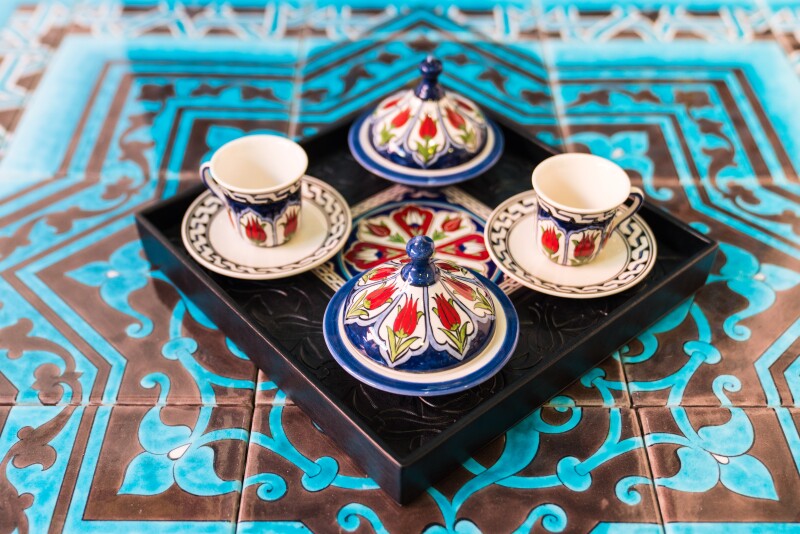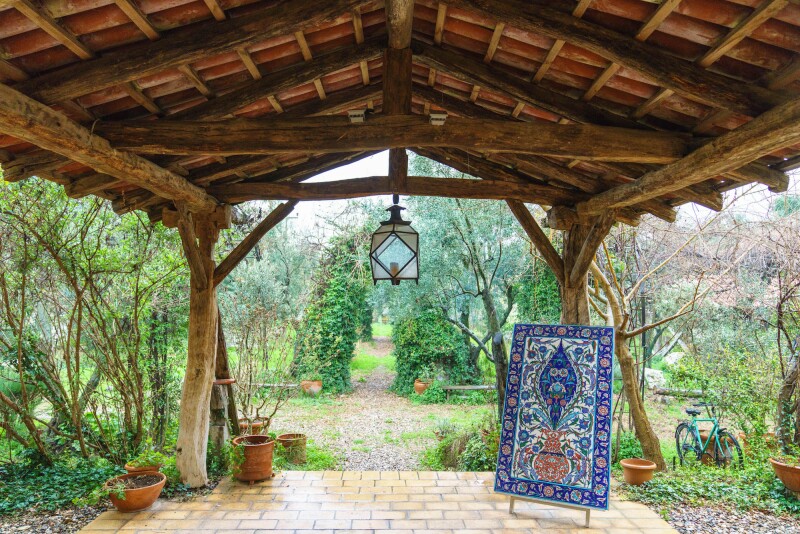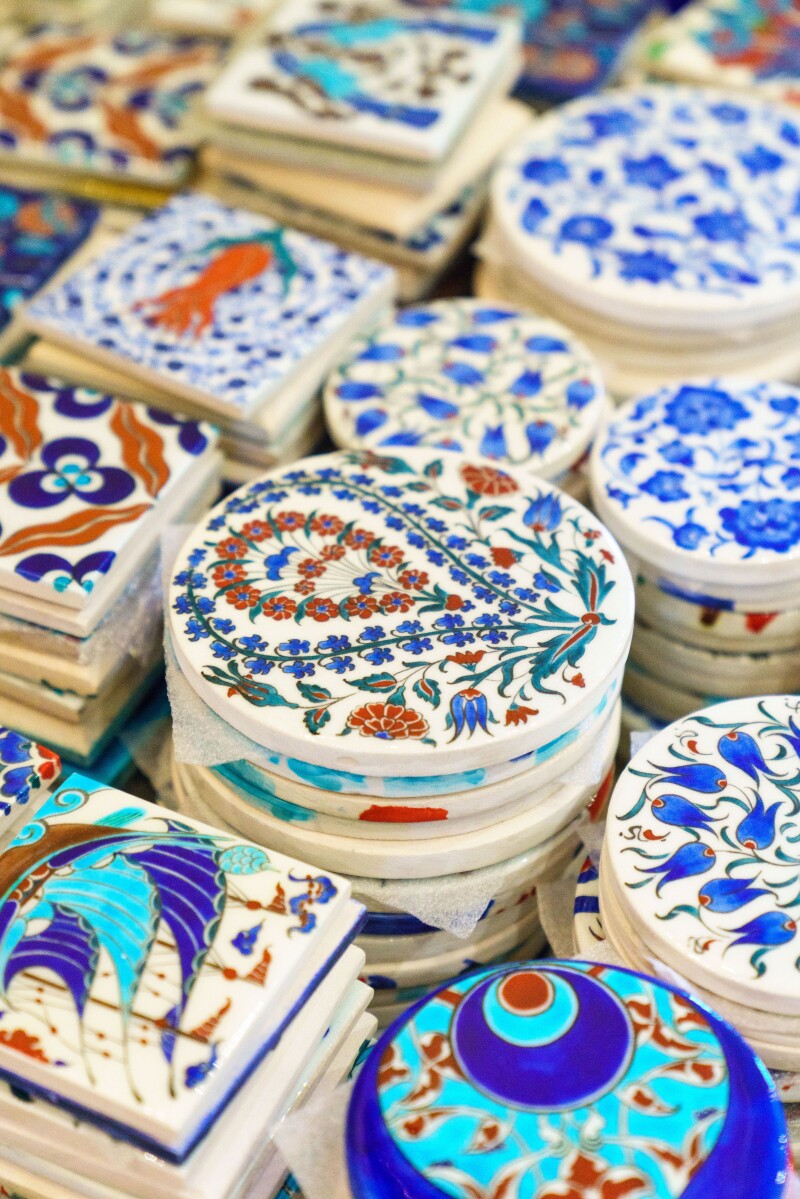Detailed, colorful Iznik ceramics are a popular Turkish souvenir. So much so that mass-produced replicas—with printed rather than handmade designs—are sold in droves on the streets of Istanbul’s Sultanahmet area for as low as $5 each. But the real pieces are valuable beyond the sentimental: a 2006 Christie’s lot of 15th-century Iznik pottery dishes sold for over $500,000. The cheap knock-offs are lovely and plentiful, but once you learn the difference, you’ll know why tracking down a real Iznik is worth the effort. The intricate production process is more than just craftsmanship; it also draws upon a rich cultural heritage. Here’s what you need to know about genuine Iznik pottery—and where to find it.

An Iznik tea set at the Anikya showroom in Istanbul
Photo by Yulia Denisyuk
A long lost tradition What makes ceramics from Iznik, an Anatolian town of bygone fame, special? The region’s pottery tradition stretches back to prehistoric times, but the art form blossomed under the Ottomans. In the late 15th century, craftsmen of Iznik replaced the traditional clay used in ceramics with quartz. The innovative technique produced a bright white base that made the four traditional colors found in Iznik pieces–turquoise, cobalt, malachite, and coral–stand out under a thick transparent glaze.
Ottoman sultans favored the new look and soon exquisite Iznik çini (pronounced “chee-nee”), as the tiles are known locally, adorned public spaces and important buildings in Istanbul, including the court’s main residence, Topkapi Palace. Iznik ceramics spread far and wide, even piquing the interest of Genoese and Venetian merchants. This golden era lasted for about 100 years. The decline of the Ottoman Empire meant a loss of protection for the craft, which had all but disappeared by the late 17th century. For the next several hundred years, original Iznik pieces appeared solely in art brokerages and museums worldwide (including the Louvre and the Smithsonian).

The Imperial Council of the Topkapi Palace is lined with Iznik tiles
Photo by Yulia Denisyuk
Today, a renewed interest in Ottoman heritage has sparked efforts to restore Iznik çini to their former glory. Turkish organizations such as the Iznik Foundation and Anikya are working to bring the craft out from the museums back into everyday life. Their founders come from different backgrounds—including academia, art, and business—but they are united by a fondness for the rich self-expression featured in Iznik ceramics and for the style’s potential to revive the traditions of the past through modern, functional art.
A painstaking process
A short ferry-and-minibus ride away from Istanbul, tiny Iznik on the shores of Lake Iznik presents a markedly different pace from that of Turkey’s largest city. Here, fueled by the personal interest of Dr. Işıl Akbaygil, an economics professor, the Iznik Foundation kick-started the revival of this traditional art form. It took the foundation three years to resurrect the long-forgotten ceramic-making process. The foundation still uses laborious 16th-century techniques (the only change was replacing the brick-and-wood kilns with electric counterparts), and it takes about 70 days to make each tile. The spacious Iznik Foundation garden villa, located outside the Roman walls that still partially encircle the town, offers a glimpse of how these stunning tiles are crafted.

The Iznik Foundation site in Iznik
Photo by Yulia Denisyuk
The process starts by creating the base, called the biscuit; 85 percent of this base is made with locally sourced ground quartz (the rest is clay and silica). Biscuits are dried for seven to 10 days and then covered with a thick underglaze made of quartz and clay. At this point, they are air dried for another 10 days, then baked at 930 degrees in giant kilns.
The next step is the most intricate. The traditional geometric and floral motifs (the latter featuring tulips, roses, and carnations) are drawn on sketching paper, perforated with a needle, and transferred onto the biscuit using charcoal dust. The tiny traces of charcoal are then carefully contoured with a black dye and the designs are painted with natural metal oxide colors. Copper oxide produces a rich cobalt blue, and iron oxide turns into the distinctive, deep Iznik red.

Designs are first drawn on sketching paper and perforated with a small needle.
Photo by Yulia Denisyuk
The last step, glazing, is where the magic happens. The painted biscuit is glazed with a thick off-white mixture of quartz, metal oxides, and soda called sır, which translates to “secret” in Turkish: The original masters never wrote down the formula, but rather passed it down orally. This final coating adds a satin finish, draws out depth in the colors, and protects the piece from the elements. It also makes the ceramics virtually indestructible. Finally, the piece is air dried and kilned again for 12 continuous hours. Transformed by fire, the pale colors burst into intense, vivid hues, and the lustrous Iznik çini is born.
A modern history you can hold
For Iznik aficionados, it’s not enough to simply restore this traditional art; they are also ushering it into the modern age by introducing contemporary designs and collaborating with international brands like Hermès and illustrious institutions like the Sheikh Zayed Mosque in Abu Dhabi. Both the Iznik Foundation and Anikya have showrooms in Istanbul where travelers can browse for authentic souvenirs, handcrafted in Iznik using those centuries’ old techniques. But perhaps the most enriching experience for a tile-loving traveler awaits at Iznik Classics.

Small Iznik tiles for sale at Iznik Classics
Photo by Yulia Denisyuk
The multi-storied gallery Iznik Classics is located in an alley behind the Blue Mosque (a name given to the Sultan Ahmet Mosque because of the more than 20,000 blue-and-white Iznik tiles that cover the interior). Owner Tahir Eğinci cares deeply about the pieces in his gallery. He likes one Iznik panel so much that he’s willing to sell it for $1 million, no less. (San Antonio Spurs coach Gregg Popovich is reportedly one of the customers who checks in regularly to see if Eğinci has changed his mind about the price. At the time of this writing, he hasn’t.) Eğinci is the keeper of stories behind each Iznik he sells, like those of Adnan Hoca, an Iznik master with 40 years of painting experience. The entire gallery basement is dedicated to Hoca and is filled with ceramics that reflect the philosophical questions he attempted to unravel in his work.
Holding a weighty, silken quartz tile in your hands can be life changing. Like the fire that births the tiles, the experience can spark an unexpected enthusiasm for the lost and revived art of Iznik. As Eğinci says, “When some customers learn the difference between the real Iznik tiles and the ones you can buy on the street, they cry.”
>>Next: This French Crystal Maker Will Change the Way You Look at Wineglasses











